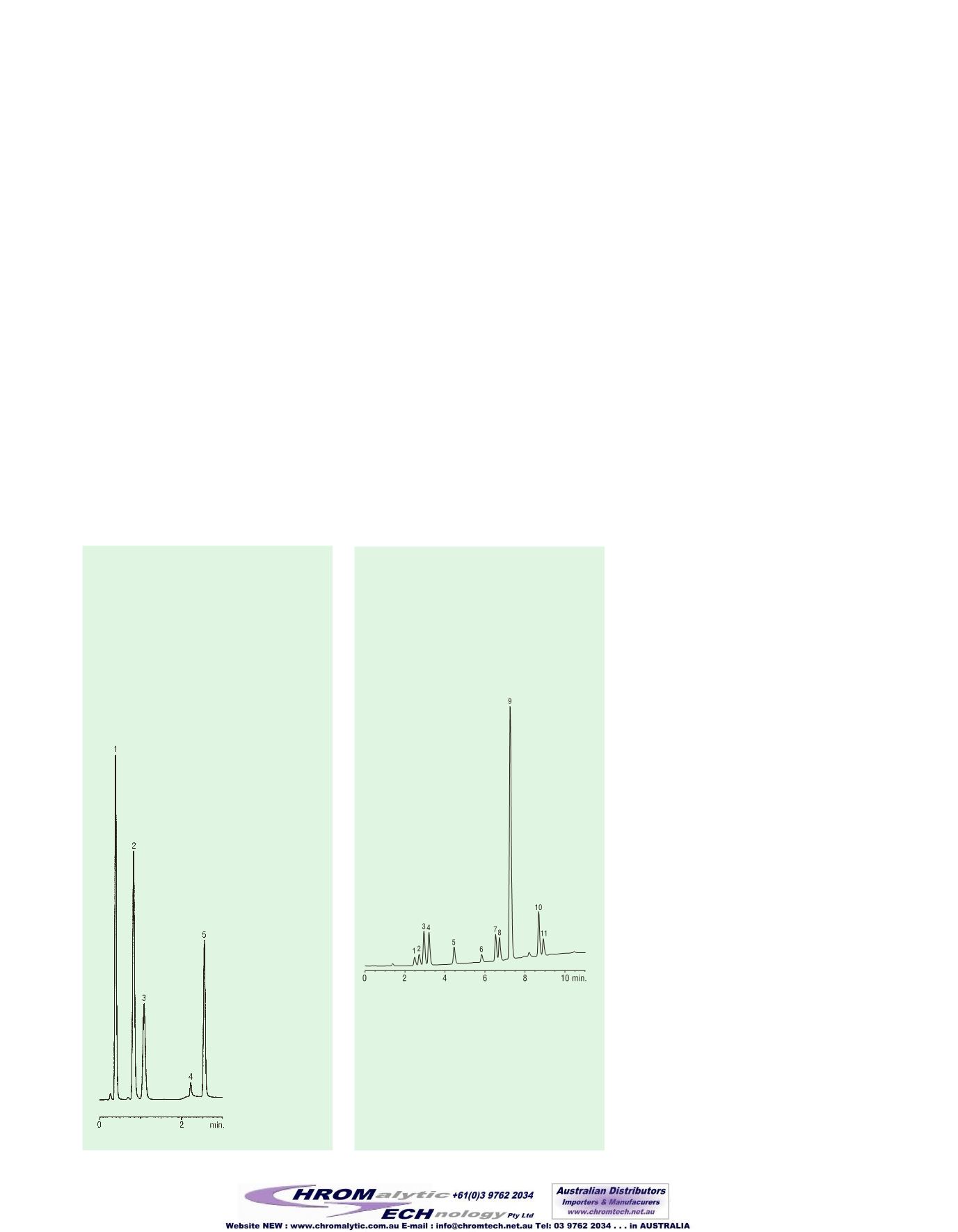

• 8 •
www.restekcorp.comRESTEK Advantage
800-356-1688
Analysis time for many HPLC separations can be
drastically reduced by using fast LC. In the example
separations we show here, analysis times of 20 to 40
minutes by conventional HPLC are reduced by 60 to
75%. Further, because columns employed in fast LC
analyses typically are less than 100mm long, analytes
spend less time in the column. Consequently, these
dramatically reduced analysis times are accompa-
nied by improved sensitivity, due to reduced band
spreading.
Fast LC analyses can be performed using either car-
tridge-style fast LC columns or short, conventional
design HPLC columns, typically containing 3µm sili-
ca-based packings. In addition to the performance
improvements attributable to short columns and
small packing particles, gains also can be realized by
using optimized, highly selective stationary phases.
Selective phases improve separation among sample
components with minimal changes in mobile phase
strength. Analysts who reduce mobile phase strength
By Vernon Bartlett, Innovations Team Manager, Terrence S. Reid, HPLC Applications Chemist, and
Rebecca Wittrig, Ph.D., Senior Innovations Chemist
Faster Separations and
Greater Sensitivity
Using Restek HPLC Columns
and Fast LC Cartridge Columns
✔
Save time—significant increases in sample throughput; fast re-equilibration in gradient analyses.
✔
Save money—reduced solvent consumption reduces purchase and disposal costs.
✔
Good screening technique for unknown analytes.
✔
Excellent for LC/MS applications.
Figure 2
— Separate carbamates and
re-equilibrate in 13 minutes, using a
short Ultra Carbamate column.
in attempts to improve selectivity and/or retention
often find k' is increased drastically, and analysis
time is unacceptably prolonged.
There are several precautions to observe before
using fast LC columns and methods. Critical separa-
tions are more sensitive to system volume; evaluate
tubing lengths and system component specifications
with a goal of minimizing internal volume. Also,
highly selective stationary phases can be required for
difficult separations (e.g., structural isomers)—we
recommend discussing your intended application
with our Technical Service group before ordering
columns and attempting a new analysis. Finally, fast
LC is not recommended for normal phase separa-
tions, nor for ion-pairing separations when gradients
are required.
Fast LC Separation of
Digitalis
Derivatives
Figure 1 shows an analysis of
Digitalis
extracts and
derivatives on an experimental 30mm x 4.0mm Ultra
Alkaloids Fast LC cartridge column, using a simple
water:acetonitrile mobile phase gradient. The analy-
sis is completed in 3 minutes, with excellent separa-
tion of the sample components. This is dramatically
reduced analysis time, relative to the cumbersome
analysis on a 30cm C18 column. The fast LC
approach, using this specialized stationary phase, can
be applied to purification and analysis of digoxin-
labeled materials in investigations of biological activi-
ty, and is perfect for high-speed cleaning validations.
Fast LC Separation of Carbamates
Figures 2 and 3 (page 9) illustrate fast LC analyses
of carbamate pesticides by HPLC/UV and LC/MS,
respectively. Total time for the HPLC/UV analysis is
approximately 13 minutes; the LC/MS analysis is
slightly longer, but is less than 20 minutes. Table I
(page 9) summarizes conditions for the LC/MS
analysis. Including re-equilibration time, the conven-
tional analysis on a 250mm x 4.6mm column takes
40 minutes. Designed especially for carbamates
analyses, Ultra Carbamate columns are available in
several dimensions in addition to the 50mm x
4.6mm and 100mm x 4.6mm columns used here.
Fast LC Analyses of Vanillin and Vanilla Extract
Figure 4 (page 9) shows fast LC analyses of
vanillin/ethyl vanillin and vanilla bean extract on a
50mm x 4.0mm Pinnacle™ DB C18 column.
Excellent separations are achieved in less than 5
minutes. Conventional analyses on 150mm x 4.6mm
C8 columns take 25 minutes overall with a mobile
phase gradient, or more than 40 minutes with an
isocratic mobile phase.
In Summary
In diverse applications, fast LC separations enhance
laboratory throughput, reduce solvent waste, and
improve method sensitivity. In some cases, mobile
phase requirements can be simplified, from gradient
elution to isocratic elution, when an optimized sta-
tionary phase is used, dramatically reducing analysis
time.
Column:
Ultra Carbamate
Catalog #:
9177355
Dimensions:
50 x 4.6mm
Particle size:
3µm
Pore size:
100Å
Conditions:
Mobile Phase:
A: 90:10 water:methanol
B: 90:10 methanol:acetonitrile
Time (min):
%B
0
10
10
90
Flow:
1.5mL/min
Temp.:
27°C
Det.:
UV @ 220nm
LC_0225
Figure 1
—
Digitalis
derivatives separated
in 3 minutes on a fast LC cartridge.
LC_0250
Peak List:
Conc.
Ret. Time (min.)
1. digoxigenin 100µg/mL 0.40
2. gitoxigenin 100µg/mL 0.80
3. digoxin
100µg/mL 1.10
4. gitoxin
~10µg/mL 2.20
5. digitoxin
100µg/mL 2.60
Sample:
Inj.:
10µL
Sample Diluent:
water:acetonitrile (80:20 v/v)
Column:
Ultra Alkaloids Fast LC Cartridge
Catalog #:
custom column
Dimensions:
30 x 4.0mm
Particle Size:
3µm
Pore Size:
100Å
Conditions:
Mobile Phase:
A: water
B: acetonitrile
Time
(min.) %B
0.0
20
1.5
20
1.51 35
3.0
35
3.1
20
Flow:
2.0mL/min
Temp.:
27°C
Det.:
UV @ 230nm
Peak List:
1. aldicarb sulfone
2. aldicarb sulfoxide
3. oxamyl
4. methomyl
5. 3-hydroxycarbofuran
6. aldicarb
7. propoxur
8. carbofuran
9. carbaryl
10. methiocarb
11. 4-bromo-3,5-dimethylcarbamate
Sample:
Inj.:
5µL
Conc.:
50µg/mL
Solvent:
methanol
Restek standards:
cat.# 32274 and 32273 mixed 50:50


















